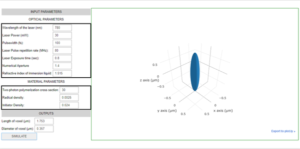Sept. 27, 2018 — As the world around us relies on smaller and smaller technologies, research to determine how to construct these minuscule structures is accelerating in importance. First, micro-manufacturing of various materials became crucial to the development of tiny technologies we know today, but researchers in the College of Engineering at the University of Illinois at Urbana-Champaign and the National Center for Supercomputing Applications (NCSA) are working to take it a step further, by creating tools to enable nanomanufacturing, or manufacturing at the nanoscale, one billion times less than standard.
That’s where Illinois’ Nanomanufacturing Node comes into play. The first of its kind, the NSF-funded nanoMFG node was awarded with a five-year grant in 2017 to advance the reliability, efficiency and general scientific understanding of nanomanufacturing, eventually releasing tools that can be used by others to explore manufacturing at the nanoscale.
In line with this goal, a pair of graduate students at the University of Illinois, Varun Kelkar and Mahfuzul Kabir, members of Illinois’ Nanomanufacturing Node and advisees of PI Kimani Toussaint, have just developed a tool to increase efficiency in construction by accurately simulating the smallest-possible structure that can be established by two-photon lithography, which turns a resin to a solid material by shooting it with light.

“The process is actually quite simple,” said Kabir. “You take a liquid material, which we call a resin, and when the light shines on it, polymerization occurs inside. Due to that chemical process, the liquid solidifies. Then the question becomes, how small of an area can you polymerize? That means that you can make really tiny structures, but how tiny?”
Kabir and Kelkar’s tool, which was published to nanoHub.org earlier this year, allows researchers to answer precisely that question without having to do their own digging.
“The software tool that we developed tries to predict the smallest structure that we can build given a certain liquid resin material and a certain light source,” Kabir said. “By taking input from users with material and optical properties, we tried to construct a three-dimensional model of the smallest feature size that can be constructed. Typically, that’s in the form of an ellipsoid.”
Given the prevalence of tiny devices, and the wide array of disciplines where groundbreaking discoveries can be enabled by them, being able to predict the size and shape of nanoscale structures is vital to the future of many industries. Though the current iteration of Kabir and Kelkar’s tool is in its beginning stages, it could very well serve as an important tool in identifying the structures of nano-scale three-dimensional structures.
Being able to predict the size of the smallest feature with accuracy is important in understanding how the 3D structures fabricated with two-photon lithography will appear after construction. “In our next version, we’d like to include a CAD (computer-aided design) model into our simulation tool. In standard 3D printing, the user prepares a CAD model of their structure which is then fabricated with the device. Often times the final constructed structure has various defects which may not be apparent from the CAD model,” said Kelkar. “You get a certain CAD design, but the machine doesn’t manufacture exactly the same because of the various non-idealities in the manufacturing process. Combining our existing calculations with a 3D CAD model will help us predict how the structure will actually be manufactured.”
“That really reduces a lot of time, improving on the iterative process of perfecting a fabricated structure,” Kelkar continued. “We’re working to make a simulated output that really predicts what a structure will look like.
“The idea is that, moving forward, we will incorporate more and more materials, especially those that are commercially available,” Kabir concluded. “We are working on creating a database where people can choose different liquid resins to work with. We are also looking at quantifying the uncertainty in our calculations.”
Being able to accurately simulate a nanoscale structure will provide crucial insight into nanomanufacturing, and as more and more materials are catalogued, predicting these tiny structures will become more efficient and viable, whether it be for research or private industry.
About NCSA
The National Center for Supercomputing Applications (NCSA) at the University of Illinois at Urbana-Champaign provides supercomputing and advanced digital resources for the nation’s science enterprise. At NCSA, University of Illinois faculty, staff, students, and collaborators from around the globe use advanced digital resources to address research grand challenges for the benefit of science and society. NCSA has been advancing one third of the Fortune 50 for more than 30 years by bringing industry, researchers, and students together to solve grand challenges at rapid speed and scale.
Source: Boswell Hutson, NCSA




























































